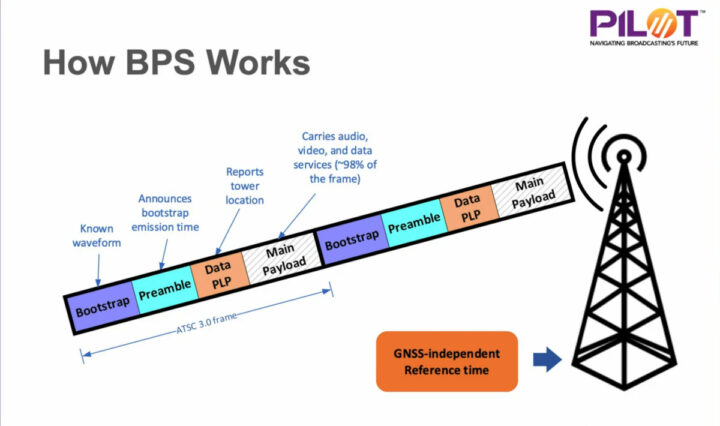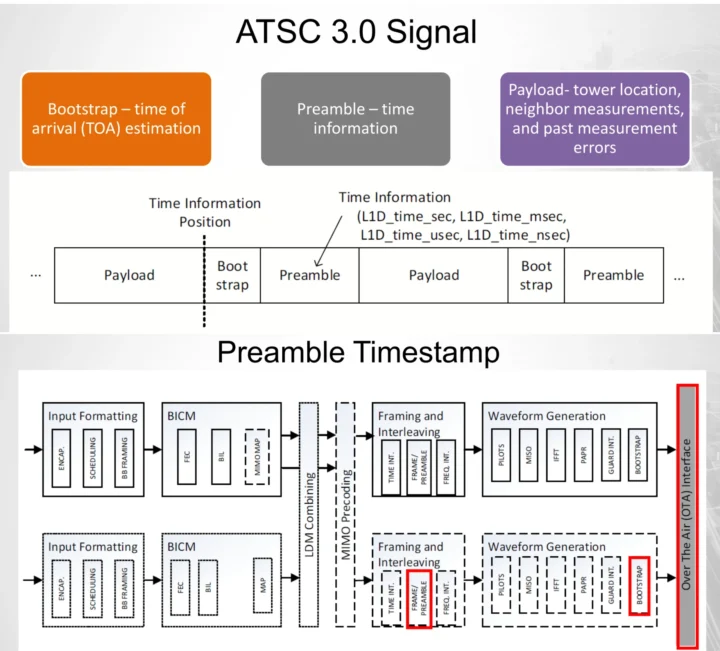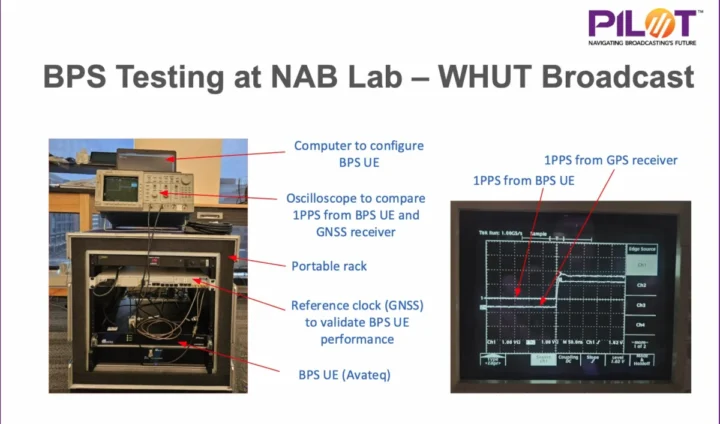Broadcast Positioning System (BPS) is an alternative to GPS designed for timing and positioning over ATSC 3.0 digital TV signals, and mainly designed as a backup solution for national security.
GPS is critical in providing not only location data, but also timing data for critical infrastructure such as power grid, telecommunication networks, and so on. However, GPS signals can be spoofed, and/or satellites could potentially be damaged or even taken down. That’s where BPS comes in as an alternative with a much broader network of base stations, and both GPS and BPS signals can be compared, meaning it can be used to detect spoofing as well.
It works by adding a preamble with timing data and a Data PLP (Physical Layer Pipe) with tower information and location. One tower is enough for timing data, and positioning will also be possible with four towers within range. Time accuracy is 100ns (95% of the time), and positioning accuracy is expected to be around 100 meters on average. We won’t see aerial antennas on cars for his purpose any time soon 😉
NAB (National Association of Broadcasters) Technology is currently testing BPS with a limited number of ATSC 3.0 base stations. The test equipment can be seen below with a computer to configure the BPS user equipment (UE), a high-end oscilloscope to measure and compare GPS and BPS 1PPS (One Pulse Per Second) signals, and a portable rack with a GSP and BPS receivers.
BPS is being developed in six phases. The fourth phase (2025-2027) will deploy ATSC 3.0-based timing to the public, the fifth phase (2026-2027) will be testing BPS positioning, and the final phase will deploy both timing and positioning over ATSC 3.0 from 2027 to 2029.
You can learn more in the presentation slides from NAB Technology, and the video below provides more details on how this all works.
BPS is all good, but it only works with ATSC 3.0 used in the US and some other countries. What about DVB-T2 and other digital TV standards? Can they also support PNT (positioning, navigation, and timing)? I could not find anything related to ISDB-T and DTMB. While there are some research papers about positioning with DVB-T2 in single frequency networks (SFN), there doesn’t seem to be an effort to deploy a solution similar to BPS in Europe, or I missed it…
Via Jeff Geerling and Hackaday.

Jean-Luc started CNX Software in 2010 as a part-time endeavor, before quitting his job as a software engineering manager, and starting to write daily news, and reviews full time later in 2011.
Support CNX Software! Donate via cryptocurrencies, become a Patron on Patreon, or purchase goods on Amazon or Aliexpress









Interesting. But isn’t it possible with 4G/5G signals? Because: DVB-T2 has only 79.000 subscribers here in the Netherlands, there is a license until 2030, so it could be turned off by then (to lower costs, and free up frequencies).
Isn’t Digital TV over the air free in the Netherlands?
Here, all TVs have a DVB-T2 tuner. At the beginning (in 2014), the government sent free DVB-T2 set-top boxes to households in Thailand. That one: https://www.cnx-software.com/2014/12/17/samart-strong-black-free-dvb-t2-receiver-in-thailand/
18 euro’s per month. Operated by commercial company KPN, under the brand name Digitenne.
Only the 3 public / government channels (NPO 1,2,3) are FTA.
Interesting.
Aside from the fact that masts are used it does not tell anything about reach and frequency. In area’s affected by GPS jamming this might e an option only if the signal reaches far enough (as secondary system for planes).
Of course when systems are jammed the masts will be the first targets for sabotage in case of a real offensive action. It might only provide a false sense of redundancy since they are stationary. Most DECCA systems have been retired, but perhaps there might be a 2nd life for groundbased positioning systems.
On some forums the gps-jamming sites are becoming very “popular”, with the jamming concentrated in a few areas, including Eastern Europe and South-East Asia.